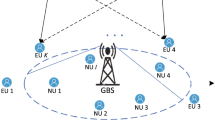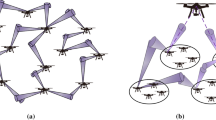Abstract
With the wide application of unmanned aerial vehicle (UAV), especially in the military field, the security of inter-aircraft communication has become a critical issue, but the wireless ultraviolet communication can be used as a new communication method to guarantee the communication of UAVs within circular cluster. This paper mainly studies the analytical model for connectivity when UAVs obey random way point (RWP) model based on ultraviolet communication within circular cluster. Connectivity is one of the most important characteristics in network, especially in high-dynamic UAV network. Simulations are made when UAVs in cluster obey uniform distribution and RWP model with modulations of OOK and PPM. The simulation results under different distributions of UAVs indicate that transmitted power required with OOK to achieve same probability of k-connectivity is about 2 times than that required with PPM, whereas the data rate required with OOK is about 0.5 times than PPM. In addition, we compare the approximation method based on the analytical model proposed in this paper with the existing approximation method in three cases, where the number of UAV is 20, 100 and 500, respectively. The simulation results show that the approximation method proposed in this paper converges to 1 much faster.













Similar content being viewed by others
Data availability statement
The datasets generated during and/or analyzed during the current study are available from the corresponding author on reasonable request.
References
Gao, T., Fan, L., Nan, G.: An emergency communication system based on UAV-assisted self-organizing network. In: 2016 10th International Conference on Innovative Mobile and Internet Services in Ubiquitous Computing (IMIS) IEEE, (2016). https://doi.org/10.1109/IMIS.2016.132
Maza, I., et al.: Experimental results in multi-UAV coordination for disaster management and civil security applications. J. Intell. Robot. Syst. 61(1–4), 563–585 (2011). https://doi.org/10.1007/s10846-010-9497-5
Pašagić Škrinjar et al.: Application of unmanned aerial vehicles in logistic processes. (2019). https://doi.org/10.1007/978-3-319-90893-9_43
Gu, J., et al.: Multiple moving targets surveillance based on a cooperative network for multi-UAV. IEEE Commun. Mag. 56(4), 82–89 (2018). https://doi.org/10.1109/MCOM.2018.1700422
Bayramov, A.A., Hashimov, E.G.: Assessment of Invisible areas and military objects in Mountainous Terrain. Def. Sci. J. 68(4), 343–346 (2018). https://doi.org/10.14429/dsj.68.11623
Yuan, R., Ma, J.: Review of ultraviolet non-line-of-sight communication. China Commun. 13(6), 63–75 (2016). https://doi.org/10.1109/CC.2016.7513203
Tian, W., et al.: Cooperative communication based connectivity recovery for UAV networks. ACM (2018). https://doi.org/10.1145/3321408.3321583
Vavoulas, A., et al.: Connectivity issues for ultraviolet UV-C networks. Opt. Commun. Netw. IEEE/OSA J. (2011). https://doi.org/10.1364/JOCN.3.000199
Vavoulas, A., Sandalidis, H., Varoutas, D.: Node isolation probability for serial ultraviolet UV-C multi-hop networks. IEEE/OSA J. Opt. Commun. Netw. 3(8), 750–757 (2011). https://doi.org/10.1364/JOCN.3.000750
Leijie, W., Yiyang, L., Zhengyuan, Xu: On connectivity of wireless ultraviolet networks. J. Opt. Soc. Am. A, Opt. Imag. Sci. Vis. 28(10), 1970–1978 (2011). https://doi.org/10.1364/JOSAA.28.001970
Hyytia, E., Lassila, P., Virtamo, J.: Spatial node distribution of the random waypoint mobility model with applications. IEEE Trans. Mob. Comput. 5(6), 680–694 (2006). https://doi.org/10.1109/TMC.2006.86
Bouachir, O., et al.: A mobility model For UAV Ad hoc network. Int. Conf. Unman. Aircraft Syst. IEEE (2014). https://doi.org/10.1109/ICUAS.2014.6842277
Chu, T., Nikolaidis, I.: Node density and connectivity properties of the random waypoint model. Comput. Commun. 27(10), 914–922 (2004). https://doi.org/10.1016/j.comcom.2004.01.003
Li, C., et al.: Study on the k-connectivity of UV communication network under the node distribution of RWP mobility model in the arbitrary polygon area. IEEE Photon. J. 12(4), 1–12 (2020). https://doi.org/10.1109/JPHOT.2020.3003896
Zhao, T., Xie, Y., Zhang, Y.: Connectivity properties for UAVs networks in wireless ultraviolet communication. Photon. Netw. Commun. 35(3), 316–324 (2018). https://doi.org/10.1007/s11107-017-0753-5
Lassila, P., et al.: Connectivity Properties of random waypoint mobility model for Ad Hoc networks. Springer US (2006). https://doi.org/10.1007/0-387-31173-4_18
Zhao, J.: Minimum node degree and k-connectivity in wireless networks with unreliable links. IEEE Int. Symp. Inf. Theory (2014). https://doi.org/10.1109/ISIT.2014.6874832
Chen, G., et al.: Path loss modeling and performance trade-off study for short-range non-line-of-sight ultraviolet communications. Opt. Exp. 17(5), 3929–3940 (2009). https://doi.org/10.1364/OE.17.003929
He, Q., Sadler, B.M., Xu, Z.: Modulation and coding tradeoffs for non-line-of-sight ultraviolet communications. Free-Space Laser Commun. IX Int. Soc. Opt. Photon. (2009). https://doi.org/10.1117/12.826301
Boudec, J.L.: Understanding the simulation of mobility models with Palm calculus. Perform. Eval. 64(2), 126–147 (2007). https://doi.org/10.1016/j.peva.2006.03.001
Author information
Authors and Affiliations
Corresponding author
Additional information
Publisher's Note
Springer Nature remains neutral with regard to jurisdictional claims in published maps and institutional affiliations.
Rights and permissions
Springer Nature or its licensor (e.g. a society or other partner) holds exclusive rights to this article under a publishing agreement with the author(s) or other rightsholder(s); author self-archiving of the accepted manuscript version of this article is solely governed by the terms of such publishing agreement and applicable law.
About this article
Cite this article
Zhao, T., Zhang, H., Lin, Y. et al. Connectivity analytical model based on UV communication when UAVs under the distribution of RWP within circular cluster. Photon Netw Commun 45, 115–127 (2023). https://doi.org/10.1007/s11107-023-00998-y
Received:
Accepted:
Published:
Issue Date:
DOI: https://doi.org/10.1007/s11107-023-00998-y




